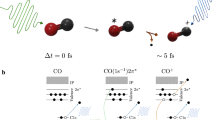Abstract
From the thermo-chemical data for the strength of the carbon-carbon single bond (about 5 × 10−3 dynes), the rate of shear was estimated for rupturing the centre bond of large hydrocarbon molecules in solution under laminar flow conditions owing to the component of the viscous drag in the direction of the long axis of the molecule. Experiments confirmed the calculated order of magnitude of the critical value of the rate of shear as a function of the chain-length of the molecule.
This is a preview of subscription content, access via your institution
Access options
Subscribe to this journal
Receive 51 print issues and online access
$199.00 per year
only $3.90 per issue
Buy this article
- Purchase on SpringerLink
- Instant access to full article PDF
Prices may be subject to local taxes which are calculated during checkout
Similar content being viewed by others
References
Morris, W. J., and Schnurmann, R., Rev. Sci. Instr., 17, 17 (1946).
Author information
Authors and Affiliations
Rights and permissions
About this article
Cite this article
MORRIS, W., SCHNURMANN, R. Mechanical Degradation of Large Molecules. Nature 160, 674 (1947). https://doi.org/10.1038/160674a0
Issue date:
DOI: https://doi.org/10.1038/160674a0
This article is cited by
-
Stress-augmented thermal activation: Tribology feels the force
Friction (2018)
-
Study of Permanent Shear Thinning of VM Polymer Solutions
Tribology Letters (2017)
-
Evaluation of high shear viscosity data from jet and concentric cylinder viscometers
Rheologica Acta (1962)
-
Initiation of Chemical Reactions by Mechanical Forces
Nature (1960)



